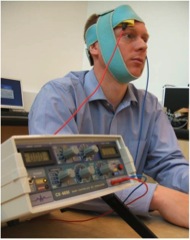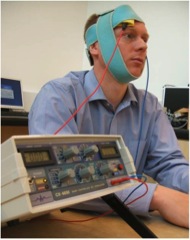You may or may not have heard of transcranial direct current stimulation (tDCS), but it is non-invasive method for stimulating the brain with low intensity electrical currents. Over the last decade or so there has been plenty of basic physiology research demonstrating that tDCS directly modulates cortical excitability. Neatly, anodal stimulation appears to increase local cortical excitability and cathodal to decrease it. It’s all rather low-fi, a little bit of circuitry, some standard AA batteries and a brain. Here’s a picture of my legendary colleague John Cossar rigged up for a zapping.
 Various forms of invasive and non-invasive brain stimulation have been considered as possible pain therapies for a long time, so it is unsurprising that something as cheap and easy as tDCS has been suggested as a potential clinical tool. tDCS has been studied in small trials as a possible treatment for depression, cravings, to improve recovery after stroke and of course for pain. In our Cochrane review of non-invasive brain stimulation (NIBS) techniques for chronic pain we identified a selection of small trials of tDCS that all suggested a positive effect, but concluded that there was not enough data to be confident of this. Our own recent small clinical pilot study in chronic back pain found no signs of such an effect.
Various forms of invasive and non-invasive brain stimulation have been considered as possible pain therapies for a long time, so it is unsurprising that something as cheap and easy as tDCS has been suggested as a potential clinical tool. tDCS has been studied in small trials as a possible treatment for depression, cravings, to improve recovery after stroke and of course for pain. In our Cochrane review of non-invasive brain stimulation (NIBS) techniques for chronic pain we identified a selection of small trials of tDCS that all suggested a positive effect, but concluded that there was not enough data to be confident of this. Our own recent small clinical pilot study in chronic back pain found no signs of such an effect.
The classic sham condition used in these trials is simple – you rig the stimulation up just the same as always but after the first 30 seconds of the standard 20 minute stimulation (during which the tingly-itchy sensation is generally at its most noticeable but fades) you secretly switch it of without the patient’s (or the assessor’s) knowledge. Hey presto – double blinding! This has been shown to ensure blinding when the intensity of stimulation is set at 1 milliamp (mA). Most clinical trials use intensities of 2mA with the assumption that double blinding is still OK but here’s the snag: the sensations associated 2mA intensity are stronger and more noticeable yet blinding at this intensity had never been validated. There is another snag – folk tend to get some temporary redness of the skin under the electrode after stimulation. If that is more noticeable following real stimulation then both assessor and participant blinding would be threatened. We all know that if blinding is not maintained then we don’t control for placebo effects (apologies to Steve Kamper for using this crude term!).
So we set out to design a study to test whether blinding was adequate at 2mA. We set up a fake trial claiming to investigate the effects of tDCS on a word memory task in healthy volunteers who had never experienced tDCS. While we had no real interest in that question we told this white lie (will full ethical approval of course) because we wanted to avoid people over- scrutinising the stimulation experience in a way that they wouldn’t have done in a normal clinical trial. After taking the memory test, getting stimulated and repeating the test again we finally asked them whether or not they thought they had received real stimulation. If the blinded assessor (that’ll be me) spotted skin redness then it was noted too. All in all we took 100 participants through the study of which 96 completed the whole thing. It was a cross-over so all participants received both conditions on different days.
So was blinding OK? In a word….nope. In the first session, when they had nothing to compare the experience to, participants could judge the stimulation condition correctly more than we would expect by chance. In the repeat session they were very accurate indeed. Also that skin redness was almost exclusive to the active condition. Blinding of assessors and participants was far from perfect.
What does this mean? There have been a fair number of reviews published over recent years that speak enthusiastically to the promise of these interventions. Our results don’t necessarily mean that tDCS is ineffective for pain, depression or anything else. But they do mean that we need to interpret the results from any trial that used 2mA tDCS (that’s the vast majority of trials in chronic pain and depression) with caution as we have demonstrated that they are at a substantial risk of bias. Better sham controls are needed before we can be confident that these tools are useful. So if you hear tDCS being touted as a therapy for pain in the immediate future – be a little sceptical. Investigating new therapies is so important, but in our haste to bring evidence to the clinic we need to be sure that we don’t gloss over or disregard vital methodological limitations.
Our paper is now published in PLoS ONE with all the lovely open access goodness that entails. You can find it here.
About Neil
 As well as writing for Body in Mind, Neil O’Connell is a researcher in the Centre for Research in Rehabilitation, Brunel University, West London, UK. He divides his time between research and training new physiotherapists and previously worked extensively as a musculoskeletal physiotherapist. He also tweets! @NeilOConnell
As well as writing for Body in Mind, Neil O’Connell is a researcher in the Centre for Research in Rehabilitation, Brunel University, West London, UK. He divides his time between research and training new physiotherapists and previously worked extensively as a musculoskeletal physiotherapist. He also tweets! @NeilOConnell
Neil is currently fighting his way through a PhD investigating chronic low back pain and cortically directed treatment approaches. He is particularly interested in low back pain, pain generally and the rigorous testing of treatments. Link to Neil’s published research here. Downloadable PDFs here.
Reference
O’Connell NE, Cossar J, Marston L, Wand BM, Bunce D, Moseley GL, & De Souza LH (2012). Rethinking Clinical Trials of Transcranial Direct Current Stimulation: Participant and Assessor Blinding Is Inadequate at Intensities of 2mA. PloS one, 7 (10) PMID: 23082174



